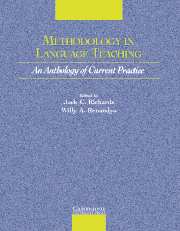Book contents
- Frontmatter
- Contents
- Acknowledgments
- Introduction
- Section I Approaches to Teaching
- Section 2 Lesson Planning and Classroom Management
- Section 3 Classroom Dynamics
- Section 4 Syllabus Design and Instructional Materials
- Section 5 Task and Project Work
- Section 6 Learning Strategies
- Section 7 Teaching Grammar
- Section 8 Teaching Pronunciation
- Chapter 16 Beyond ‘Listen and Repeat’: Pronunciation Teaching Materials and Theories of Second Language Acquisition
- Chapter 17 PracTESOL: It's Not What You Say, But How You Say It!
- Section 9 Teaching Speaking
- Section 10 Teaching Listening
- Section 11 Teaching Vocabulary
- Section 12 Teaching Reading
- Section 13 Teaching Writing
- Section 14 Assessment
- Section 15 Technologies in the Classroom
- Section 16 Professional Development
- Credits
- Author Index
- Subject Index
- References
Chapter 17 - PracTESOL: It's Not What You Say, But How You Say It!
Published online by Cambridge University Press: 10 November 2010
- Frontmatter
- Contents
- Acknowledgments
- Introduction
- Section I Approaches to Teaching
- Section 2 Lesson Planning and Classroom Management
- Section 3 Classroom Dynamics
- Section 4 Syllabus Design and Instructional Materials
- Section 5 Task and Project Work
- Section 6 Learning Strategies
- Section 7 Teaching Grammar
- Section 8 Teaching Pronunciation
- Chapter 16 Beyond ‘Listen and Repeat’: Pronunciation Teaching Materials and Theories of Second Language Acquisition
- Chapter 17 PracTESOL: It's Not What You Say, But How You Say It!
- Section 9 Teaching Speaking
- Section 10 Teaching Listening
- Section 11 Teaching Vocabulary
- Section 12 Teaching Reading
- Section 13 Teaching Writing
- Section 14 Assessment
- Section 15 Technologies in the Classroom
- Section 16 Professional Development
- Credits
- Author Index
- Subject Index
- References
Summary
INTRODUCTION
To communicate effectively, language learners need to become proficient in using the semantic, syntactic, lexical, morphological and phonological elements of the language being learnt. They also need to understand its pragmatic use. The focus in ESL literature has tended to be on grammatical, thematic and functional approaches to ESL syllabus design. As the title of this paper suggests, intelligibility entails more than simply using appropriate lexical items and correct word order: Words stressed incorrectly or with inappropriate pitch or intonation will impede the learner in getting the intended message across. Phonology, then, should be an integral part of any ESL lesson/syllabus. What follows is an outline of one way to approach incorporating a phonological component into ESL lessons. It is based on the following assumptions about oral communication:
Speaking usually involves two or more people who use language for interactional or transactional purposes. It is not the oral expression of written language. This should be reflected in the types of activities used in ESL classrooms.
Spoken language imparts referential and affective meaning. When we speak, we reveal our interest and attitudes toward the topic being discussed and toward the people we are speaking with. These messages are largely conveyed through the prosodic features of language: stress and rhythm, intonation, pitch variation and volume. For these reasons, it would seem essential that phonology be learned in context and not treated incidentally and/or separately. In addition to making decisions about content, grammatical structures, lexical items, functions, skills, methodology and materials, we need to identify phonological elements as well.
[…]
Information
- Type
- Chapter
- Information
- Methodology in Language TeachingAn Anthology of Current Practice, pp. 188 - 200Publisher: Cambridge University PressPrint publication year: 2002
References
Accessibility standard: Unknown
Why this information is here
This section outlines the accessibility features of this content - including support for screen readers, full keyboard navigation and high-contrast display options. This may not be relevant for you.Accessibility Information
- 3
- Cited by
